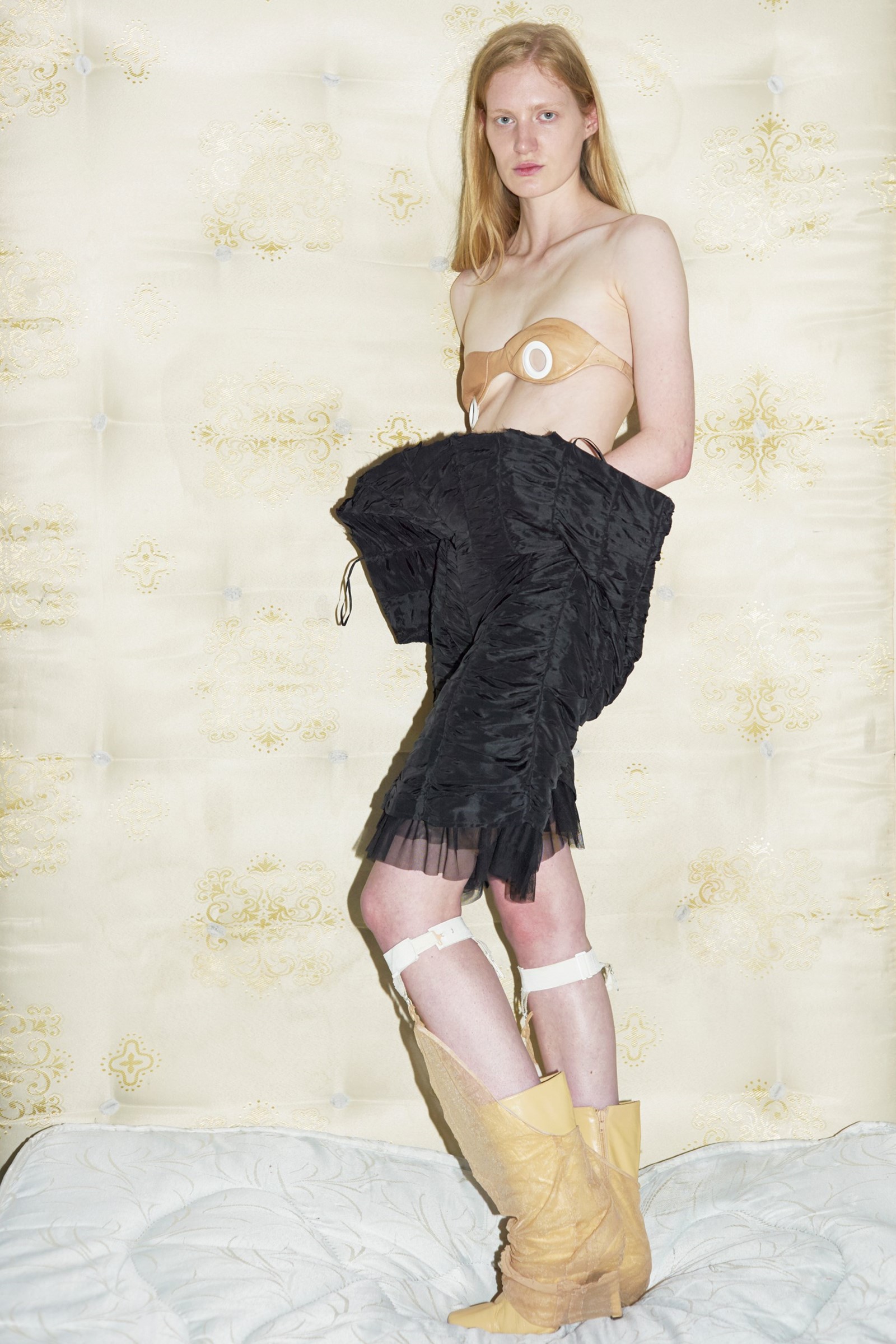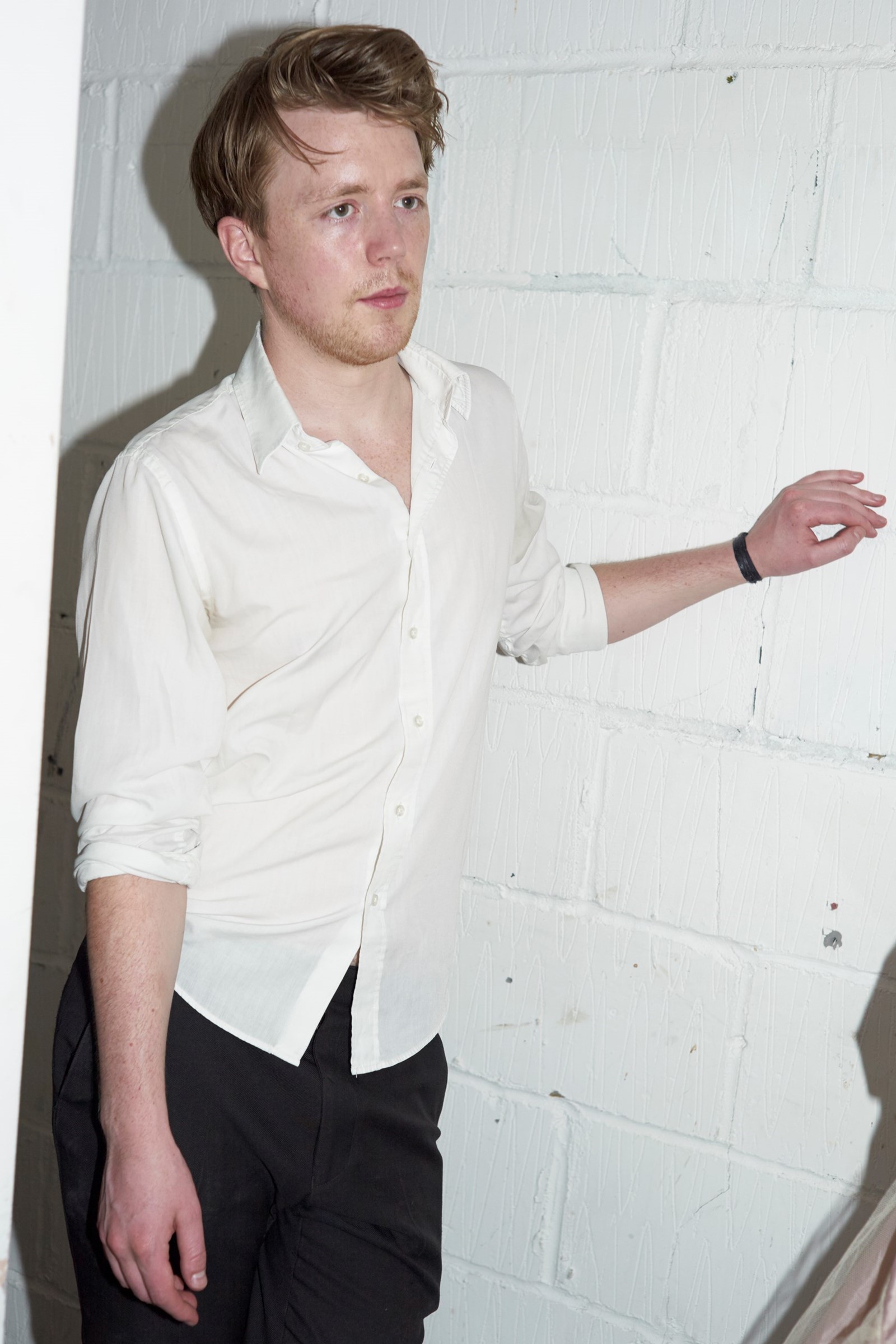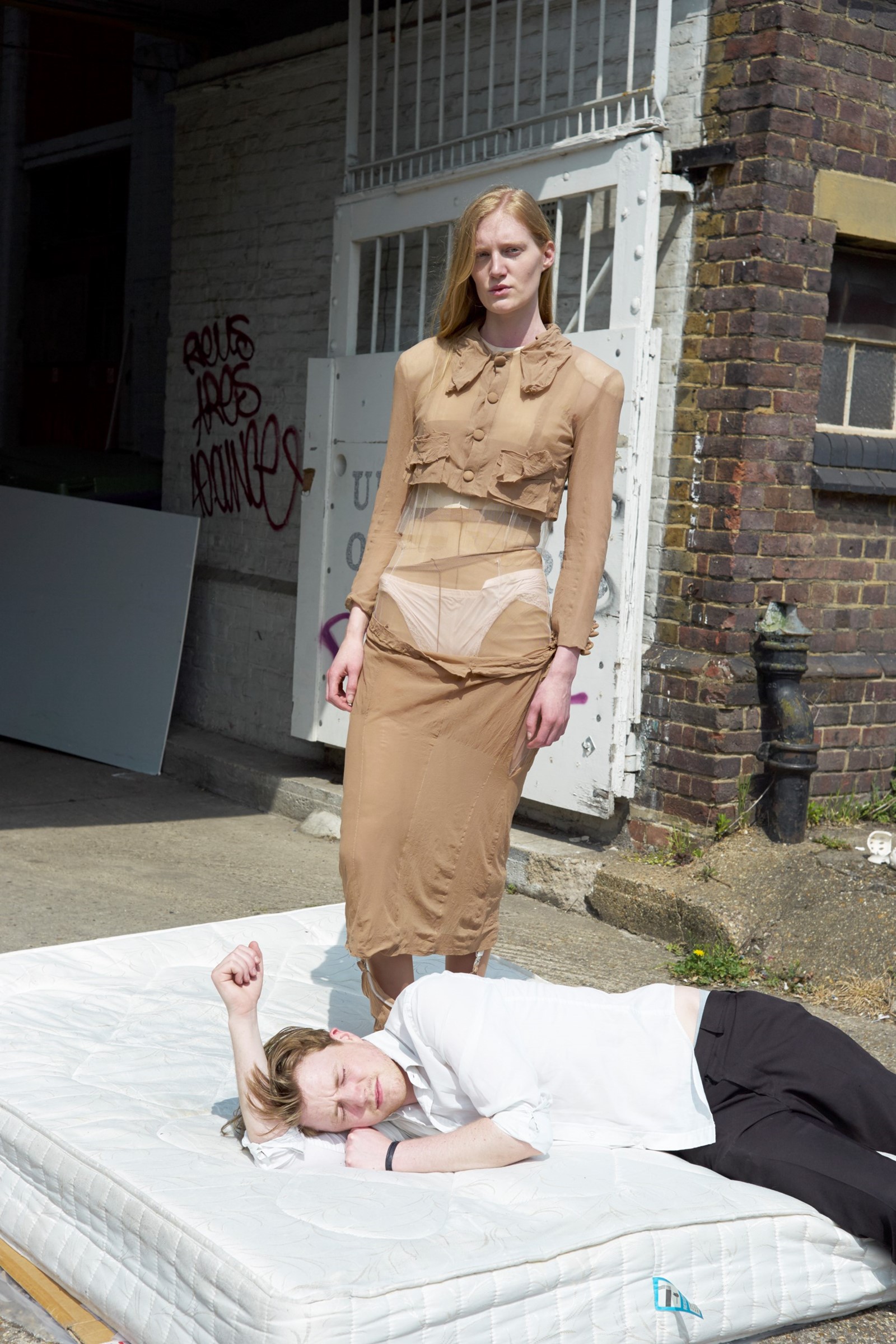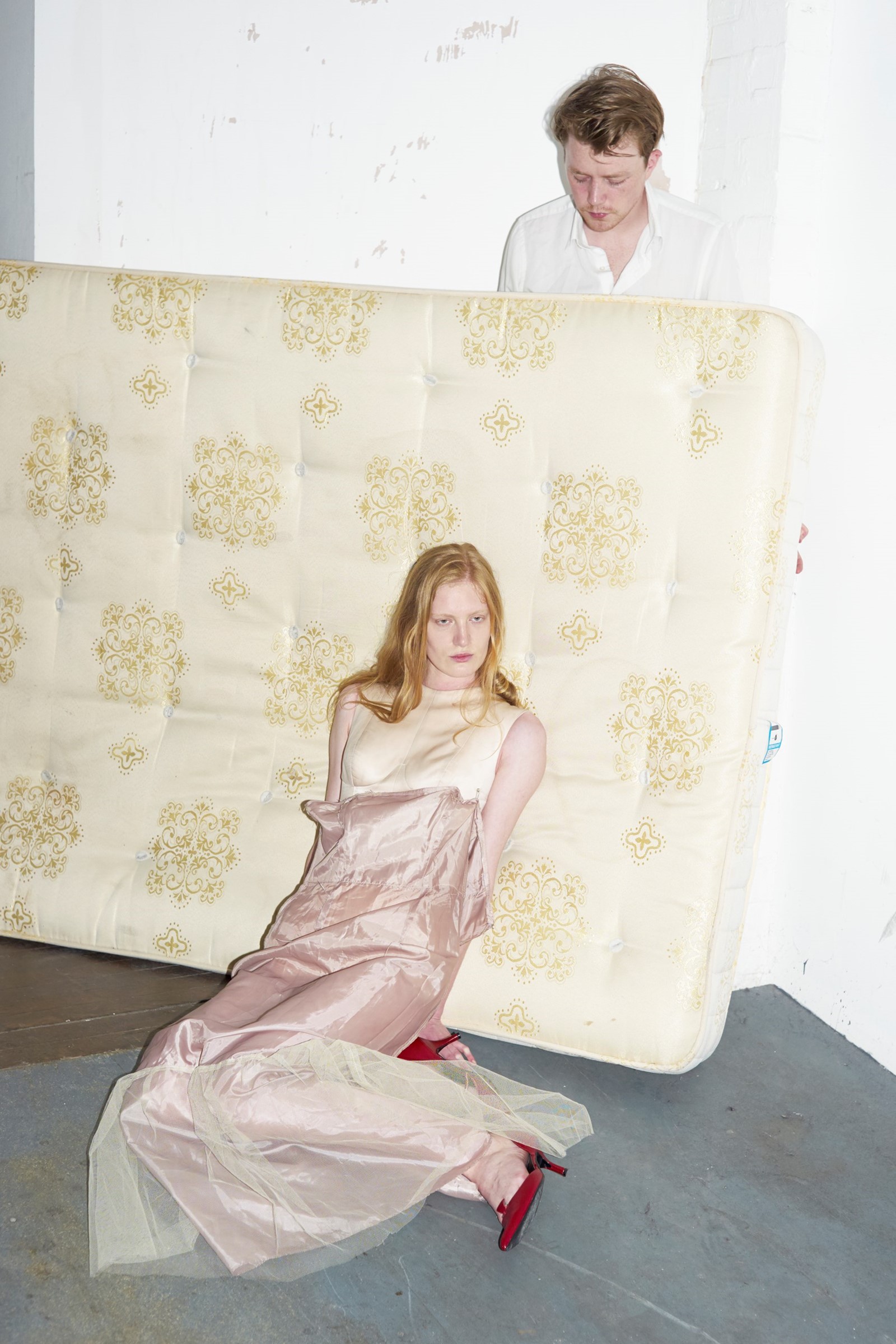Spread across the table in front of Harry Pontefract is a selection of photographs of middle-aged women, each varying in size and disposition and erotically posing nude in an assortment of beige living rooms. These snapshots of suburban sexuality, which Pontefract found in a shoebox at a Surrey car boot sale, evoked the Sheffield-born designer’s exploration the nuances of sex, taste, and nostalgia in his recent graduate collection, particularly visible through his use of nude tights. Pontefract is obsessed by tights, finding their grannyish association, second-skin nature and lifespan that culminates in sagging both fascinating and titillating. Their manipulation under his hands is almost grotesquely impactful – thus, he was selected to open the Central Saint Martins MA show at London Fashion Week, and for the audience, it was immediately visible that Pontefract was seeking to subvert codes of sartorial conservatism. His clothes cover up bodies, yet are collaged from seemingly naughtier ingredients: silk slips, garters, brassieres, cheap handbags, and, of course, 10 denier tights that are layered, patchworked and displaced, styled as if they are falling from the bodies that wear them.
“It started with this elderly woman on my paper round who used to wait for me with the door ajar,” Pontefract begins to explain in his soft Yorkshire lilt, which remains discreetly monotone throughout our conversation. “I was about 13 and it was such a confusing situation for an adolescent boy. I was in this awfully stagnant care home and one minute I’d be looking at the dirty mags and the next there’d be this old lady standing there. It was about that feeling of inappropriate and ambiguous sexuality.”
“It started with this elderly woman on my paper round who used to wait for me with the door ajar” – Harry Pontefract
It might all sound rather Harold and Maude, but what Pontefract’s work is essentially about is the ambiguity of association by memory – the idea that what one may find sentimental or nostalgic, another may find sexy or shameful. His collection is crafted from an assemblage of found objects, each one with its very own memory and experiences, and the materials he has made himself may have a saved-from-a-skip look, but are actually deceptively laboured. It all pertains to an ambiguity that Pontefract enjoys – I can see it when he asks what my first impressions of the collection were; partly, I imagine, because of his own mixed feelings about it. “I wanted to leave it to the viewer to see how fucked up it is,” he says. “I didn’t go out and decide to do a sexy or dark collection. People confess to finding something sexy if it’s what Ann Summers says is sexy; people don’t usually admit to finding saggy, nude tights or stained underwear to be sexy.”

Even if you don’t find Pontefract’s work sexy, or even sexual, there’s no denying its intelligence, craft and wit. The idea of turning tights into trousers, or prom dress linings into skirts, also requires a thoroughness in execution. Having never sat at a sewing machine and called thread ‘string’ on his BA at Westminster University, Pontefract honed his technical skills in the couture and embroidery studios of Alexander McQueen during his placement year. “It taught me to commit to the long-haul,” he says. “Everything there was cut well and had perfect linings, and the sewing was done directly on the bases – that’s the difference between McQueen and brands that plonk a bit of embroidery onto a calico base.”
“Me and the guy who was helping me [source tights] had to wear them for a few days to really stretch them out” – Harry Pontefract
As well as toying with eroticism and nostalgia, Pontefract enjoys trompe l’œil fabrics, which make inexpensive materials look expensive, and expensive things look cheap. His panelled body suits and cargo trousers, which are inspired by Girls Aloud’s Nicola Roberts (cast your mind back to that mid-noughties cargo-vest combo), are cut from blemished goat suede, sewn together by thread that had been rubbed through dirt, and then burnished with oil and wax. Cheap silk-satin prom dresses are treated with mink oils and lined with tulle before becoming skirts, and pleather-like handbags have been transformed into tailored bandeaus, some with the straps still attached. Pontefract sourced his tights from a man he met online, who runs a side business in selling dead stock pre-elastane hosiery in Rochdale. “Me and the guy who was helping me had to wear them for a few days to really stretch them out,” he says with a cheeky grin.

Fabio Piras, head of CSM’s MA Fashion course, decided to open the show with Pontefract’s collection because he felt it summed up the course’s point of view. “It was super personal, and had such a strong narrative and identity because of that,” he says. “The way he works is like a true artist – the collection really understood femininity and had a privacy and subtlety to the aesthetic.” Piras is keen to add that the level of quality was superb, and Pontefract has already been reached out to by several brands that specialise in luxury product. “There’s an obsessiveness to it that I love – the fact that he had to go to these car boot sales and find something so specific and then had a real commitment and engagement with craft. At first, there was a danger that he was producing work with such selective memory, so I was opportunistically glad that he found those photographs because they had so much information and they could have been his in a different lifetime.”
“There’s an obsessiveness to it that I love – the fact that he had to go to these car boot sales and find something so specific” – Fabio Piras
After the Central Saint Martins show became Vogue.com’s most clicked-on of the week, fashion’s most formidable clotheshorses, Rihanna and Kim Kardashian, came knocking for a piece of Pontefract, who declined their advances. “If I handed it over so soon, I would’ve lost all sensibility and it wouldn’t be mine – it would become the saggy tights that Rihanna wore,” he explains. “I just worked my bollocks off for a year, so I wasn’t particularly feeling it, and the people that would wear this would wear it regardless of Rihanna.” Kardashian’s other half, Kanye West, however, has a reputation for snooping around Central Saint Martin’s MA studios and swallowing up young talent for his own design endeavours. “It’s bullshit at the end of the day. Kanye wants what [young designers] have. If you’re in that much debt and someone waves a pay cheque in front of you, it’s an obvious choice, but I don’t want to do that.”

One woman that Pontefract certainly considers pivotal to the collection is his mother, Sue. Not only are her bra, camisole and tights seen in the collection, but Pontefract also used her as a fit model. “I started dressing her up and she’s totally blasé about it and doesn’t really ask any questions,” he says, before joking about his own “mummy issues”. Mrs Pontefract’s bra was deconstructed, lined and finished with stiff tulle and silk chiffon, and then rewired to keep its shape, and her white camisole became a skirt held up by a garter. “What I find hilarious is that as soon as I take it out of my mum’s cupboard, I look at it in a different context.” Wasn’t his mother slightly dismayed by her youngest son’s appropriation of her intimates? “It is quite revealing. She was a bit embarrassed when she saw her bra coming down the runway on a really small model.”
“What I find hilarious is that as soon as I take it out of my mum’s cupboard, I look at it in a different context” – Harry Pontefract
Pontefract’s mother is nonetheless supportive of her son’s plans to work eponymously, albeit impecuniously. He insists that, despite the lost-and-found quality to his materials, much of his collection is reproducible – especially the tights-turned-trousers, which are hand-stitched and lined in Irish linen. “I’m working to get this to the quality I want in October and focusing on getting it in the places that I want to see it,” he explains of his decision to avoid fashion’s biannual seasons for now. “We’ll do more when it feels right. If you’ve got a personal relationship with stockists, they’ll understand. Further down the line, when I have more capital, hopefully it’ll be easier to work to their schedule.”
The designer is protective over some pieces, however, which he has no desire to reproduce – much like his precious shoebox of homemade porn. He says that he’ll continue to trawl through markets for such gems, citing Portobello on a Friday, Spitalfields on a Thursday, Wimbledon on a Wednesday, Battersea on a Sunday, and one in Surrey once a month, as his preferred stomping grounds. “It’s always about taking things that have a memory, even if it isn’t personal to me, and things that are really cheap that you can then turn into luxury – if you want to call it that.” Like I said, Pontefract takes pleasure in ambiguity.
